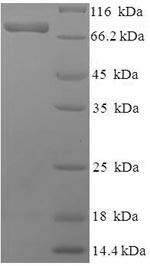This Human PGM3 recombinant protein was produced in E.coli, where the gene sequence encoding Human PGM3 (1-542aa) was expressed with the N-terminal 6xHis-SUMO tag. The purity of this PGM3 protein was greater than 90% by SDS-PAGE.
The main function of PGM3 is to catalyze the isomerization reaction of N-acetylglucosamine-6-phosphate (GlcNAc-6-P) to N-acetylglucosamine-1-phosphate (GlcNAc-1-P). This is a chemical transformation of a substrate that is crucial for various biosynthetic and metabolic pathways. PGM3 plays a critical role in the biosynthesis of glycoproteins. Glycoproteins are a class of proteins that have specific sugar molecules attached to them, and these sugar molecules are essential for the stability and function of the proteins. The activity of PGM3 ensures the proper biosynthesis of glycoproteins.
PGM3 is also associated with the function of the immune system. Certain mutations or defects may result in impaired PGM3 function, affecting the normal functioning of immune cells. This could lead to immunodeficiency, making individuals more susceptible to infections. PGM3 deficiency or mutations may be associated with a rare genetic disorder known as PGM3 deficiency disease (PGM3-CDG). This disease can lead to various symptoms, including immune system issues, neurological problems, and growth retardation.






